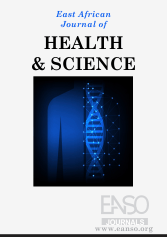Preliminary Assessment of the Awareness Level of Radon and its Health Risks among High School Science Teachers and Health Workers in Nagongera, Tororo Uganda
الملخص
This study aims to evaluate the awareness levels regarding radon, its associated health risks, and potential mitigation strategies among high school science teachers and health workers in Nagongera Sub County, Tororo District, Uganda. Tororo District, known for its rich natural mineral resources, particularly around the Osukuru Hills, has attracted numerous industries. The combination of mineral-rich geography and substandard building structures may elevate health risks for residents due to radon exposure. An instrumental case study approach was adopted, utilizing a questionnaire designed to assess the awareness of radon-related health risks alongside demographic information such as occupation. The study surveyed 30 health workers and 30 high school science teachers, totalling 60 respondents. Findings revealed that fewer than half of the health workers (30%) and high school science teachers (40%) were aware of radon as a radioactive substance and its health implications. These results highlight the need for targeted efforts by relevant authorities to improve radon awareness among the general population in the district
التنزيلات
المراجع
Alaamer, A. S. (2012). Radon Awareness among Saudi People in Riyadh, Saudi Arabia. World Journal of Nuclear Science and Technology, 2, 165–168.
Andersen, C. E. (2001). Numerical modelling of radon-222 entry into houses: an outline of techniques and results. Science of the Total Environment, 272(1–3), 33–42.
Biira, S., Kisolo, A. W., & D’ujanga, F. M. (2014). Concentration levels of radon in mines, industries and dwellings in selected areas of Tororo and Busia districts, Eastern Uganda. Advances in Applied Science Research, 5(6), 31–44.
Cronin, C., Trush, M., Bellamy, W., Russell, J., & Locke, P. (2020). An examination of radon awareness, risk communication, and radon risk reduction in a Hispanic community. International Journal of Radiation Biology, 96(6), 803–813.
Darby, S., Hill, D., Auvinen, A., Barros-Dios, J. M., Baysson, H., Bochicchio, F., … others. (2005). Radon in homes and risk of lung cancer: collaborative analysis of individual data from 13 European case-control studies. Bmj, 330(7485), 223.
Esan, D. T., Obed, R. I., Afolabi, O. T., Sridhar, M. K., Olubodun, B. B., & Ramos, C. (2020). Radon risk perception and barriers for residential radon testing in Southwestern Nigeria. Public Health in Practice, 1, 100036.
Frumkin Howard, & Jonathan Samet M. (2008). indoor air has raised concern that it may also be a cause of lung cancer for the entire. A Cancer Journal for Clinicians, 51(6), 1–14.
Hardback, B. (1995). 14 Radon Toxicity. The National Academies of Sciences, Engineering, and Medicine, (1995), 1–34.
Kwok, T. F., Yeung, C. H., & Xu, Y. (2017). Swaying public opinion on nuclear energy : A field experiment in Hong. Utilities Policy, 1–10. https://doi.org/10.1016/j.jup.2017.04.001
Lantz, P. M., Mendez, D., & Philbert, M. A. (2013). Radon, smoking, and lung cancer: the need to refocus radon control policy. American Journal of Public Health, 103(3), 443–447.
Mwitondi, K., Al Sadig, I., Hassona, R., Taylor, C., & Yousef, A. (2018). Statistical estimate of radon concentration from passive and active detectors in Doha. Data, 3(3), 22.
Riesenfeld, E. P., Marcy, T. W., Reinier, K., Mongeon, J. A., Trumbo, C. W., Wemple, B. E., & Kaminsky, D. A. (2007). Radon awareness and mitigation in Vermont: a public health survey. Health Physics, 92(5), 425–431.
Saphina Biira. (2019). Overview of nuclear energy reactor safety and the key issues for Uganda. Journal of Engineers Registration Board, (4), 92–95.
Vogeltanz-Holm, N., & Schwartz, G. G. (2018). Radon and lung cancer: What does the public really know? Journal of Environmental Radioactivity, 192(January), 26–31. https://doi.org/10.1016/j.jenvrad.2018.05.017
WHO. (2009). WHO handbook on indoor radon: a public health perspective. World Health Organization.
الحقوق الفكرية (c) 2024 Nahori Baniyo, Saphina Biira

هذا العمل مرخص حسب الرخصة Creative Commons Attribution 4.0 International License.




























